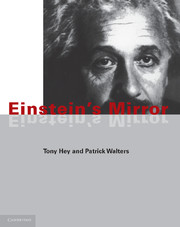Book contents
- Frontmatter
- Contents
- Preface
- 1 A revolution in time
- 2 The nature of light
- 3 Light and time
- 4 The ultimate speed
- 5 E = mc2
- 6 Matter and anti-matter
- 7 Little Boy and Fat Man: relativity in action
- 8 Down to earth
- 9 Warped space
- 10 The Big Bang, black holes unified fields
- 11 Afterword: Relativity and science fiction
- Appendix: Some mathematical details and derivations
- Chronology
- Glossay
- Quotations and sources
- Suggestions further reading
- Name index
- Subject index
- Plate section
3 - Light and time
Published online by Cambridge University Press: 05 March 2013
- Frontmatter
- Contents
- Preface
- 1 A revolution in time
- 2 The nature of light
- 3 Light and time
- 4 The ultimate speed
- 5 E = mc2
- 6 Matter and anti-matter
- 7 Little Boy and Fat Man: relativity in action
- 8 Down to earth
- 9 Warped space
- 10 The Big Bang, black holes unified fields
- 11 Afterword: Relativity and science fiction
- Appendix: Some mathematical details and derivations
- Chronology
- Glossay
- Quotations and sources
- Suggestions further reading
- Name index
- Subject index
- Plate section
Summary
The introduction of a luminiferous aether will prove to be superfluous.
Albert Einstein, in ‘The electrodynamics of moving bodies’, 1905The momentous day in May
In May of 1905, Einstein was twenty-six years old, and his ten-year struggle with the problems of relativity was about to come to a triumphant climax. About a year before this, he had begun to feel that the velocity of light must be universal – independent of the motion of the source. If this were true, then there was no need to worry about motion relative to any mythical aether, and the null result of Michelson and Morley became obvious: the speed of light is the same in both arms of the apparatus, whatever direction they are pointing relative to the Earth's motion. But the Earth does move round the Sun – so something was wrong with the ‘relativity’ of Galileo and Newton and their familiar addition of velocities, at least where light is concerned. As we asserted in chapter 2, and as we shall show in the next chapter, in Einstein's relativity speeds do not add up in the expected way. We are also forced to re-think our notions of space and time. This new vision of space and time is what we shall look at in this chapter. Let us start by recalling what Galileo and Newton believed, before looking at Einstein's version of the relativity principle.
In the sixteenth century, it seemed natural to believe that, if the Earth was moving, neither an arrow shot straight up nor a stone dropped from a tower would follow the same straight-line path.
- Type
- Chapter
- Information
- Einstein's Mirror , pp. 46 - 67Publisher: Cambridge University PressPrint publication year: 1997

